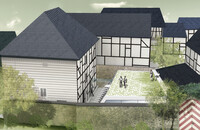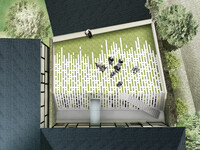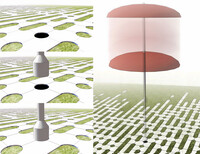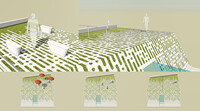



Virtual Garden - Green Roof on a Media Library
Media libraries are libraries enhanced by digital offerings. They are characterized by state-of-the-art application-oriented technologies. The architecture and appearance of the media library of the Hochsauerlandkreis must be a mirror of the new possibilities.
Based on the order structure O and 1 of the computer and the raster-microscopic image of a CD, the outer appearance of the extension becomes a metaphor of the digital world and its quantitatively unlimited storage capacity. In its appearance, the extension thus does justice to the modernity of a media library.
Garden and virtual space are connected. The inner theme penetrates to the outside. The digital 0 and 1 pattern of the outer skin gradually dissolves from the alley. The walkable area becomes less the garden and its greenery more dominant. The skin of the extension is made of a lawn stone that can be used in a differentiated way, allowing closed and open green spaces. The walkability of the roof can be designed according to the requirements.
The old town of Arnsberg is characterized by the variation of width and narrowness. Narrowness is not negative, but an unmistakable characteristic and prerequisite of the spatial quality of an old town. The design uses the existing theme at the site and develops the typology of the alley. Historical substance and extension are clearly differentiated by the alley.
The form of the extension is unpretentious, simple and derived from the internal and external necessities of differentiation and illumination. It manages without noisy superstructures and spatially subordinates itself to the circumstances. Inside, lit by the openings to the alley and the gap above the museum courtyard wall, an open floor plan guarantees maximum flexibility.
The garden area is an interpretable space. A plug-in system within the lawn stones allows for a variety of spatial combinations of tables, umbrellas, and seating. Groupings and individual positions create a use adapted to the situation.